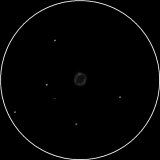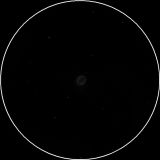
| MESSIER 57 |
|---|
RA: |
18h 53m 36s |
|
DEC: |
+33° 02' 00'' |
|
Type: |
Planetary nebula |
|
NGC: |
6720 |
|
Magnitude: |
8.80 |
|
Surface brightness : |
9.00 |
|
Apparent dimensions : |
1.4'x1.0' |
|
Distance: |
2,300 ly |
|
Discovered by Antoine Darquier de Pellepoix in 1779. The famous ring nebula M57 is often regarded as the prototype of a planetary nebula, and a showpiece in the northern hemisphere summer sky. Recent research has confirmed that it is, most probably, actually a ring (torus) of bright light-emitting material surrounding its central star, and not a spherical (or ellipsoidal) shell, thus coinciding with an early assumption by John Herschel. Viewed from this equatorial plane, it would thus more resemble the Dumbbell Nebula M27 or the Little Dumbbell Nebula M76 than its appearance we know from here: We happen to view it from near one pole. The central star was discovered in 1800 by the German astronomer Friedrich von Hahn (1742-1805), with a 20-foot FL reflector. This object is a planet-sized white dwarf star, which shines at about 15th magnitude. It is the remainder of a sunlike star, probably once of more mass than our sun, which has blown away its outer envelopes at the end of its Mira-like phase of evolution. Now over 100,000 K hot, it will soon start to cool down, shine as a white dwarf star for a while of several billions of years, and then eventually end as a cold Black Dwarf. A good value for the distance still needs to be determined (e.g., parallax by Hubble Space Telescope), but recently improved CCD technics was used at the US Naval Observatory (USNO) to determine a trigonometric parallax for the central star of M57, yielding 2,300 ly. From the expansion rate of one arc second per century given above, the age of the nebula can be roughly estimated under the assumption of constant expansion. For its extension of 60x80 arc seconds, this yields a time of expansion of about 6,000 to 8,000 years. As most planetary nebulae, the Ring is much brighter visually at magnitude 8.8 than photographically at only 9.7 mag; a consequence of the fact that most light is emitted in very few particular spectral lines. The mass of the nebular matter has been estimated at about 0.2 solar masses, the density at about 10,000 ions per ccm (cm^3). Its chemical composition has been determined as follows: On each Fluor (Fl) atom, the Ring Nebula contains 4.25 million atoms of Hydrogen (H), 337,500 Helium (He), 2,500 Oxygen (O), 1,250 Nitrogen (N), 375 Neon (Ne), 225 Sulfur (S), 30 Argon (Ar) and 9 Chlorine (Cl) atoms. It is expanding at 20 to 30 km/s, and approaching us at 21 km/s. M57 was the second planetary nebula to be discovered (in January 1779), 15 years after the first one, M27. Antoine Darquier de Pellepoix (Darquier), who discovered the Ring Nebula only a few days before Charles Messier found and cataloged it, described it as "a dull nebula, but perfectly outlined; as large as Jupiter and looks like a fading planet." This comparison to a planet may have influenced William Herschel, who found the objects of this type resembling the planet newly discovered by him, Uranus, and introduced the name "Planetary Nebulae". Herschel described M57 as "a perforated nebula, or ring of stars;" this was the first mention of the ring shape. Oddly, the inventor of the name "Planetary Nebula" did not count this most prominent representative in this object class, but described it as a "curiosity of the heavens", a peculiar object. Herschel also identified some of the superimposed stars, and correctly assumed that "none [of them] seems to belong to it." M57 is very easy to locate as it is situated between Beta and Gamma Lyrae, at about one-third the distance from Beta to Gamma. It can be seen with binoculars as an almost stellar object, difficult to identify just because of its small apparent diameter. In smaller amateur telescopes, the ring becomes apparent at about 100 magnification, with a darker middle; a 12th-mag star is east of the planetary nebula, about 1' of the center. If ever color is notable, the Ring Nebula appears slightly greenish, not unexpected because most of its light is emitted in few green spectral lines. Even in small scopes, a slight ellipticity can be noted, with major axis in a position angle of about 60 deg. With increasing aperture and under good condition, more and more detail becomes visible, but even in large instruments, the central star will be apparent only under exceptionally good conditions, or with the help of filters. In large instruments, several very faint foreground or background stars can be glimpsed within the nebula's extension under very good conditions. |
||
Other sketches |
|||||
 |
|||||
Messier 57 (May 06) |
|||||
VEDRAN VRHOVAC© 2006.-2007. |
